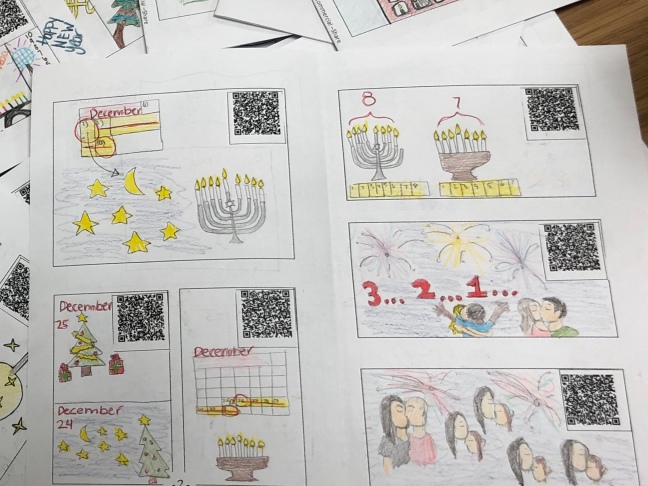
The book “A Natural Approach to the Year” (aka “Year One”) by Tina Hargaden and Ben Slavic outlines the 6th and last instructional cycle which includes the end of the year project. The project is a student-made storybook. Currently, the CI Liftoff Facebook group is abuzz with classes making books. I thought this project was awesome as well, but I did have to make some adaptions to the process to fit ASL.
I mostly followed the same instructions, rubric and rough draft packet, with some slight adjustments. You can find those here. One of my Spanish teacher colleagues created a half page template for the storybooks. Her template was portrait orientation, but my final product would be a PowerPoint, so I tweaked her template to be landscape. You can find that free download here.

As the students were writing their rough drafts, I asked them to sign their sentences first and then gloss them onto the packets. I did not require them to video their rough draft sentences, but I will definitely change that for next year. The problem I ran into is students were “glossing” (or often just writing in English) things that they wanted in their story, but they had no idea how to sign them. When I checked their rough draft and asked them to sign the sentences, many couldn’t. So next year I will have them outline their ideas in the rough draft packet, but they will video the sentences for me to correct and give feedback.
After, completing the rough draft, they began drawing their illustrations and videoing the final draft videos for each page. This year I had the students submit their videos in Flipgrid in topics designated for each page of the book. So essentially everyone’s page 1 video was in one location. This made it very difficult to check each group’s work and progress because I had to look in 15 to 20 different places. Next year I will make a topic for each group and have them label each video with a page number.

In my instructions, I asked the students to turn in the videos in Flipgrid, make the videos square and turn off the audio. I also asked that they download each submission to their phone as they went. Unfortunately I didn’t make that clear enough and about 90% did not save their videos. Therefore I had to go manually download all their videos and give them back to them through OneDrive to be able to put into the PowerPoint. After hours of downloading their videos, my lesson was learned. Saving their own videos will be strongly emphasized next year. I may even have them crop their videos in PowerPoint (a feature only available on the computer program) and not turn in the videos in Flipgrid at all for their final drafts.

When they completed the illustrations, I collected them and scanned them into images. I returned the digital scanned illustrations to them also in OneDrive. They then took the illustrations and videos and merged them together into a PowerPoint.
I ran into a few snags when they started making the PowerPoints. Our class has an OLD class set of iPads and 6 Chromebooks. I found that inserting videos into PowerPoint only worked in the mobile/tablet apps or the program on a computer. The online versions of PowerPoint didn’t work. Luckily, most kids had phones that they were able to download the apps. I made this tutorial to help guide them through the process of making the PowerPoint.
After all of the PowerPoints are complete, I can choose to turn the best ones into videos. You can do this in the computer program of PowerPoint by recording the timings by selecting “Record” and simply clicking through the presentation. Afterward you can export to video. Even if you choose not to turn them into videos, the PowerPoint itself is awesome. They can click through the pages and replay the videos as many times as necessary to understand.
It’s taken a little over 3 weeks of working on it everyday. I regret that it left little time for input activities, but in May it was a welcomed break from being “on stage” everyday. My students’ and my energies are low at this time of year and it was nice way to end the year with something that gave the kids a fun way to show off all that they’ve learned this year.
Here are a few short clips of the first final projects I’ve had turned in so far. I’m really happy with how they are turning out!
Please let me know if I can clarify any of this!
Keep signing!
Stacy 🤟🏼











